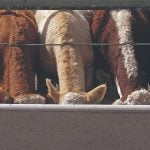Spring calving preparations normally include gathering tools, repairing equipment and gates, and buying medications, hygienic and other treatment supplies. Once those items are checked off the list, most farmers and ranchers feel ready for the calving rush. Fortunately, most deliveries proceed normally but occasionally complications such as retained placentas occur, which demand additional preparations.
Labour and delivery are usually thought of as three distinct stages with the third involving the expulsion of the placenta or fetal membranes.
“Fetal membranes and placentas are interchangeable terms,” says Dr. Meredyth Jones, veterinarian and owner of Large Animal Consulting and Education in Perkins, Oklahoma. “The placenta is the sheet of tissue connecting the dam and calf from a blood and nutrition standpoint. It’s the entire unit, the mommy side and the baby side as I like to say, and it should be shed with the calf, or soon after it’s born.”
Read Also

The Canadian Cattle Association’s international advocacy efforts
Global ag policies affect Canadian food policy, so the Canadian Cattle Association participates in international and domestic forums
When events don’t follow the natural timeline, the risks of a retention range from minor unpleasant odours to more serious uterine infections and toxins released into the cow’s system, leading to loss of future fertility, sickness and even death.
Mind the timeline
Jones explains there’s an exhaustive list of causes, but the biggest culprit is dystocia. When the uterus becomes too exhausted it’s unable to contract sufficiently to expel the placenta. Often, this occurs in heifers delivering bull calves as they are more likely to need assistance and males are generally larger than heifer calves. Other noteworthy causes include a deceased calf or a C-section.“They also happen in calving-induced situations,” Jones says. “Unfortunately, our induction drugs are an artificial way to initiate delivery. Whenever we mess with Mother Nature, we might have to pay a price.”
She says that during the normal calving timeline, when the calf is ready to be born, it announces this by releasing stress hormones. The dam responds with her own hormonal release. When these events are distorted by an abortion, or the cow calving prematurely for any reason, the system doesn’t work as it should.
“If the calf doesn’t send the signal, the hormonal cascade doesn’t happen,” Jones says. “When we induce early calving, our artificial hormone is similar to the one the calf releases but it’s not the real one. Often, things don’t flow from this artificial molecule like they would out of the real hormone. These events result in more retention issues.”
As with all production diseases, prevention should be the goal before focusing on treatment. Selecting easier-calving bulls to match female frame sizes is a key first step. Calving management considerations like early intervention, one to two hours after the membrane appears, will also help reduce uterine exhaustion from prolonged calving experiences. Additionally, nutrition plays a large role in maintaining proper uterine function. Trace mineral deficiencies of selenium, copper, cobalt and zinc combined with a lack of vitamins A, D and E have been associated with an increase in retained fetal membranes.
Questions around intervention
Jones says the most common questions she hears on the subject are whether people should intervene, and if so, when and how should they do it. While most veterinarians’ timelines will vary, in general, a placenta is considered retained six to 12 hours post-calving. If the female seems to be doing well, eating, drinking and taking care of her calf, Jones advises producers to simply monitor her attitude and appetite. If she appears sick in any way, a veterinarian should be informed as retained tissue is at high risk to create a uterine infection. After three to four days, even though she may appear healthy, a further examination is wise. An intervention by a veterinarian comes with its own controversy as treatment options have changed significantly. It was once normal practice to use a tub to lavage the uterus with saline and water or insert antibiotic or antiseptic uterine boluses. Jones doesn’t recommend these practices, believing they may irritate the uterine lining and cause long-term damage.
“There’s also the school of thought that the internal bacteria help the placenta let go quicker,” she says. “We’re talking about microscopic fingers gripping onto the inside of the uterus, so those must break down. This bacterium may be a necessary part of helping this happen.”
If the cow appears sick, Jones prefers to use injectable antibiotics, especially when there’s evidence the infection may be affecting the entire body rather than just the uterus.
She also discourages manual removal of the membranes. In the past, the belief was held that improved hygiene, aesthetics, odour control and the risk of infection decreases with forced removal of the membranes.
“Instead, manual removal has been shown to result in more severe infections, damage the endometrium and reduce the function of white blood cells important for controlling infection,” Jones says. “If we go in there and start messing around, pulling too hard before it’s ready, we can end up with a worse infection and damage to the uterine lining.”
She pinpoints retention’s immediate issue as systemic infections affecting attitudes and appetites. A temporary reduction in milk production will also limit calf growth. Longer-term problems include deeper infections which influence fertility. The extent depends on how far the infection travelled, how much was present and the extent of damage.
“My biggest emphasis is making sure anytime we manipulate the back end of a cow that we’re being clean. If we introduce infection, it will set these negative aspects up and make things worse,” she says. “And seek advice from a veterinarian if there are concerns.”
















